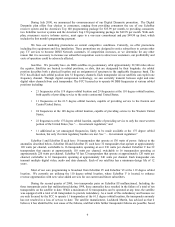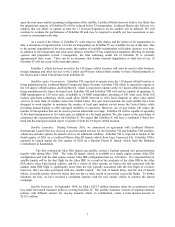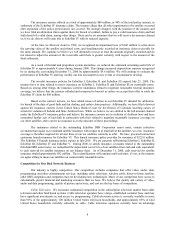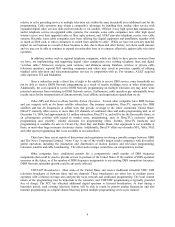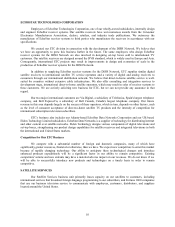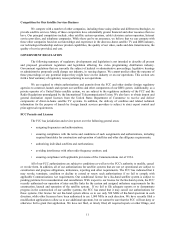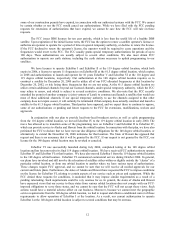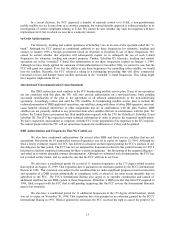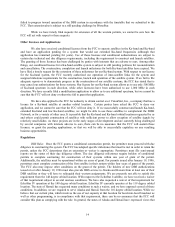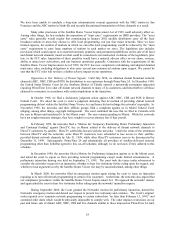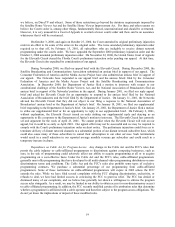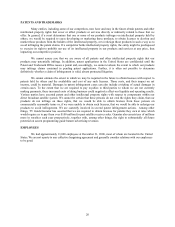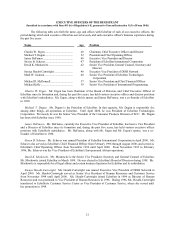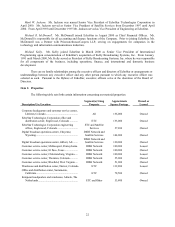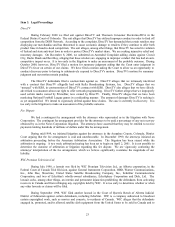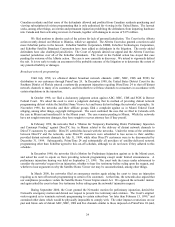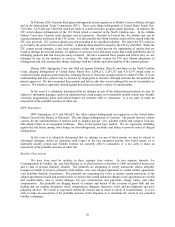Dish Network 2000 Annual Report Download - page 18
Download and view the complete annual report
Please find page 18 of the 2000 Dish Network annual report below. You can navigate through the pages in the report by either clicking on the pages listed below, or by using the keyword search tool below to find specific information within the annual report.16
Foreign satellite systems also are potential providers of DBS service within the United States. In May 1996,
in its DISCO II proceeding, the FCC proposed permitting foreign satellite systems to serve the United States if the
home country of the foreign-licensed satellite offers open “effective competitive opportunities” in the same type of
satellite service to United States licensed satellites. In the February 1997 World Trade Organization Agreement, the
United States offer contained an exemption from market opening commitments for, among other things, DBS and
direct-to-home satellite services. In November 1997, the FCC released new rules that maintained the effective
competitive opportunities test with respect to foreign-licensed satellites seeking to provide DBS and direct-to-home
satellite services in the United States. The FCC also established a strong presumption in favor of authorizing
foreign-licensed satellites to provide services other than DBS and direct-to-home satellite in the United States. The
FCC has also reached bilateral protocols allowing the provision of DBS service by satellites licensed by Mexico and
Argentina.
The FCC has proposed allowing non-geostationary orbit fixed satellite services to operate on a co-primary
basis in the same frequency as DBS and Ku-based FSS services. If the proposal is adopted, these satellite operations
could provide global high-speed data services. In addition to possible interference concerns, this would, among other
things, create additional competition for satellite and other services. In the same rulemaking, the FCC has also
requested comment on a request that would allow a terrestrial service proposed by Northpoint Communications, Inc.
to retransmit local television or other video and data services to DBS subscribers or others in the same DBS
spectrum that we use throughout the United States. Furthermore, the Satellite Home Viewer Improvement Act of
1999 required the FCC to make a determination by November 29, 2000 regarding licenses for facilities that will
retransmit broadcast signals to underserved markets by using spectrum otherwise allocated to commercial use,
possibly including DBS spectrum. Northpoint has been allowed by the FCC to conduct experimental operations in
Texas and Washington, D.C. We have submitted numerous pleadings jointly with DirecTV to the FCC expressing
concern over the Northpoint request, which in our view, may cause potential harmful and substantial interference to
the service provided to DBS’ customers. DirecTV and we have also jointly conducted tests of Northpoint’s proposed
technology and have presented our test results, which in our view show harmful interference from Northpoint’s
proposed service, and Northpoint has filed oppositions to our submissions. Furthermore, other entities have now
filed applications similar to the one filed by Northpoint. If Northpoint, or other entities become authorized to use our
spectrum, they could cause harmful and substantial interference into our service. On December 8, 2000, the FCC
released a Report and Order and Further Notice of Proposed Rulemaking in this proceeding. Despite our objections,
the FCC concluded that a terrestrial “point-to-multipoint” service can generally share the spectrum with DBS on a
no interference basis - a conclusion that may have a significant adverse impact on our operation. At the same time,
the FCC initiated a further notice of proposed rulemaking to determine the appropriate interference standards with
which such a terrestrial service must comply. The FCC also requested proposals on how to process applications for
licenses for the new service, and tentatively proposed excluding satellite companies from such licenses. In addition,
appropriations legislation that was recently enacted requires independent testing of the Northpoint technology, and
creates rural loan guarantees for providers of certain types of services. The independent tests mandated by statute are
ongoing. The statute set a deadline for completion of the tests, and FCC officials have reportedly stated that they
expect testing to be completed beyond the statutory deadline. We cannot be sure whether and when these processes
will result in the licensing of Northpoint and/or companies proposing a similar service to operate in the spectrum
licensed to us, what the interference standards will be, and how significant the interference into our operations will
be.
Distant and Local Broadcast Signals. We believe that our ability to deliver local programming via satellite
into the markets from which the programming originates helps us attract subscribers who would not otherwise be
willing to purchase satellite systems. Although we have commenced providing local network service to eligible
subscribers in various metropolitan centers, subject to certain conditions, our ability to provide such a service is
limited as detailed below.
Satellite Home Viewer Improvement Act and Retransmission Consent. The Copyright Act, as amended by
the Satellite Home Viewer Improvement Act of 1999, permits satellite retransmission of distant network channels
only to “unserved households.” Whether a household qualifies as “unserved” for the purpose of eligibility to receive
a distant network channel depends, in part, on whether that household can receive a signal of “Grade B intensity” as
defined by the FCC. In February 1999, the FCC released a report and order on these matters. Although the FCC
declined to change the values of Grade B intensity, it adopted a method for measuring it at particular households.
The FCC also endorsed a method for predicting Grade B intensity at particular households. In addition, the Satellite


